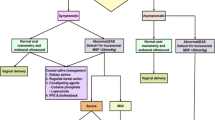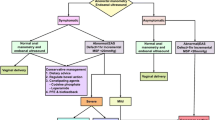Abstract
Introduction and hypothesis
To prospectively evaluate anorectal symptoms, quality of life (QoL), sphincter integrity and function after subsequent childbirth following previous obstetric anal sphincter injuries (OASIS).
Methods
A validated Manchester Health Questionnaire, endoanal sonography and manometry were performed during the third trimester and 13 weeks postpartum. Women without objective compromise of anal function were recommended a vaginal delivery and the others a caesarean section.
Results
Seventy-three consecutive women with previous OASIS were seen during a subsequent pregnancy of whom 59 were reviewed 13 weeks following delivery. Anal manometry findings did not change significantly following a subsequent vaginal delivery or caesarean section. Only one new defect (internal sphincter) occurred after a vaginal delivery. There was no significant change in symptoms or QoL. Three (6.8%) sustained repeat OASIS.
Conclusions
Women who have no antenatal evidence of objective compromise of anal sphincter function can be reassured that a vaginal delivery is not associated with any significant deterioration in function or QoL.


Similar content being viewed by others
References
Fernando RJ, Sultan AH, Radley S, Jones PW, Johanson RB (2002) Management of obstetric sphincter injury: a systematic review and national practice survey. BMC 2:9
Harkin R, Fitzpatrick M, O’Connell PR, O’Herlihy C (2003) Anal sphincter disruption at vaginal delivery: is recurrence predictable? Eur J Obstet Gynecol Reprod Biol 109(2):149–152
Peleg D, Kennedy CM, Merrill D, Zlatnik F (1999) Risk of repetition of a severe perineal laceration. Obstet Gynecol 93:1021–1024
Faltin D, Petignat P, Reuse C, Dumps P, Nunno C, Pierrot B et al (2005) A prospective cohort study of vaginal delivery after a previous anal sphincter tear. Neurorurol Urodyn 23:5–6
Bugg GJ, Kiff ES, Hosker G (2001) A new condition-specific health related quality of life questionnaire for the assessment of women with anal incontinence. BJOG 108:1057–1067
Sultan AH, Kamm MA, Hudson CN, Thomas JM, Bartram CI (1993) Anal sphincter disruption during vaginal delivery. New Engl J Med 329:1905–1911
Thakar R, Sultan AH (2004) Anal endosonography and its role in assessing the incontinent patient. Best Pract Res Clin Obstet Gynaecol 18:157–173
Royal College of Obstetricians and Gynaecologists (2001) Management of third and fourth degree perineal tears following vaginal delivery. RCOG Press, London RCOG Guideline No. 29
Norton C, Christiansen J, Butler U, Harari D, Nelson RL, Pemberton J, Price K, Rovnor E, Sultan A (2002) Anal Incontinence. In: Abrams P, Cardozo L, Khoury, Wein A (eds) Incontinence, 2nd edn. Health Publication, Plymouth, pp 985–1044
Fynes M, Donnelly V, Behan M, O’Connell PR, O’Herlihy C (1999) The effect of second vaginal delivery on anal sphincter function and faecal incontinence: a prospective study. Lancet 354:983–986
Bek KM, Laurberg S (1992) Risks of anal incontinence from subsequent vaginal delivery after a complete obstetric anal sphincter tear. BJOG 99:724–726
Sultan AH, Monga AK (1997) Anal and urinary incontinence in women with obstetric anal sphincter rupture. BJOG 104:753–754
Williams A, Lavender T, Richmond DH, Tincello DG (2005) Women’s experiences after a third-degree obstetric anal sphincter tear: a qualitative study. Birth 32:129–136
Sultan AH, Thakar R (2007) Third and fourth degree tears. In: Sultan AH, Thakar R, Fenner D (eds) Perineal and anal sphincter trauma. Springer, London, pp 33–51
Dandolu V, Gaughan JP, Chatwani AJ, Harmanli O, Mabine B, Hernandez E (2005) Risk of recurrence of anal sphincter lacerations. Obstet Gynecol 105:831–835
Poen AC, Felt-Bersma RF, Strijers RLM, Dekker GA, Cuesta SGM, Meuwissen SGM (1998) Third degree obstetric perineal tear: long-term clinical and functional results after primary repair. Br J Surg 85:1433–1438
Sze EHM (2005) Anal incontinence among women with one versus two complete third-degree perineal lacerations. Int J Gynecol Obstet 90:213–217
Sangalli MR, Floris L, Faltin D, Weil A (2000) Anal incontinence in women with third or fourth degree perineal tears and subsequent vaginal deliveries. Aust NZ J Obstet Gynaecol 40:244–248
Fenner DE, Genberg B, Brahma P, Marek L, DeLancey JOL (2003) Fecal and urinary incontinence after vaginal delivery with anal sphincter disruption in an obstetrics unit in the United States. Am J Obstet Gynecol 189:1543–1550
Sultan AH, Monga AK, Kumar D, Stanton SL (1999) Primary repair of obstetric anal sphincter rupture using the overlap technique. BJOG 106:318–323
Nichols CM, Lamb EH, Ramakrishnan V (2005) Differences in outcomes after third- versus fourth-degree perineal laceration repair: a prospective study. Am J Obstet Gynecol 193:530–534
Sultan AH, Stanton SL (1996) Preserving the pelvic floor and perineum during childbirth—elective caesarean section? BJOG 103:731–734
Malouf AJ, Norton CS, Engel AF, Nicholls RJ, Kamm MA (2000) Long term results of overlapping anterior anal-sphincter repair for obstetric trauma. Lancet 355:260–265
Sultan AH, Kamm MA, Hudson CN, Bartram CI (1994) Third degree obstetric anal sphincter tears: risk factors and outcome of primary repair. BMJ 308:887–891
Acknowledgement
I. Scheer was funded by a grant from the Mayday Childbirth Trust.
Conflicts of interest
None.
Author information
Authors and Affiliations
Corresponding author
Rights and permissions
About this article
Cite this article
Scheer, I., Thakar, R. & Sultan, A.H. Mode of delivery after previous obstetric anal sphincter injuries (OASIS)—a reappraisal?. Int Urogynecol J 20, 1095–1101 (2009). https://doi.org/10.1007/s00192-009-0908-8
Received:
Accepted:
Published:
Issue Date:
DOI: https://doi.org/10.1007/s00192-009-0908-8




